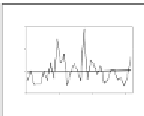Geography Reference
In-Depth Information
Figure 2.6
Precipitation trends spanning 30-60 years at seven meteorological stations (solid
circles) surrounding our survey area in Jianshe Township, Aksai County, Gansu.
Yumen
Yumen
120
120
Jiuquan
80
180
80
40
120
40
Xinjiang
0
60
1953 1963
1973
1983
1993
0
1953 1963
1973
1983
1993
Year
Year
0
1935 1945 1955 1965 1975 1985
Year
1995
Dunhuang
90
60
Gansu
30
0
1962
1972
1982
1992
Year
Survey
Area
Tuole
400
Lenghu
300
50
200
25
100
1957 1967
1977
1987
Year
Qinghai
0
1957 1967
1977
1987
Year
Da Qaidam
Dulan
160
240
180
80
120
0
1957 1967 1977 1987
Year
Tibet
60
1954
1964
1974
1984
Year
Was this sample of weather stations anomalous? Could it be that, although there is no
indication of decreasing precipitation surrounding this particular area, the drying claim
would be supported by looking at other data? It certainly does not appear so. Weather data
have been assessed by various researchers, and none has used exactly the same sources,
methods, time-periods, or geographic categorization. Yet, one looks in vain for statistical
evidence of decreasing precipitation over the past four to five decades in western China,
from Xinjiang to Inner
Mongolia, from Tibet to Ningxia. Certainly there have been in-
dividual weather stations that have shown declines with time—precipitation is markedly
variable on a year-to-year basis in such an arid and topographically complex region—but
there simply is no sign of a general drying trend. If anything, there is a weak signal that
precipitation amounts, particularly during spring and perhaps early summer, have actually
tended to increase since the 1960s (but if so, by only a tiny amount).
21
With a few exceptions, reliable weather recording has only taken place in western China
since the early 1950s, so another possibility to examine is whether, while there has
been no
general drying trend
during the past half-century or so, these years themselves have been,










































Search WWH ::

Custom Search